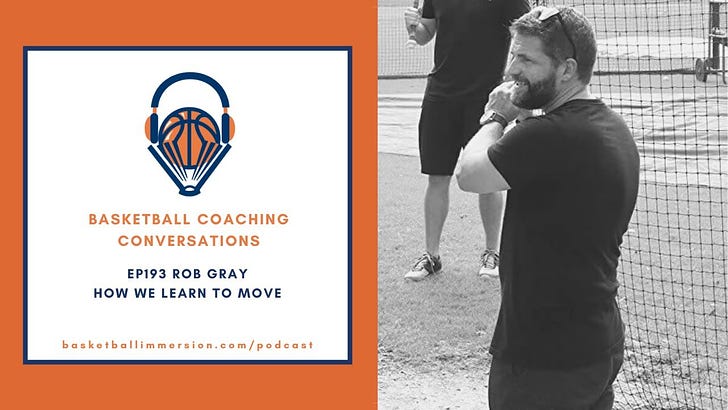Episode XV: Learning to Move, Four Card Triggers, Lead by Listening & Time on Task
"Successful leaders balance pride with humility: absolute pride in performance; total humility before the magnitude of the task."
I’ve been sharing this newsletter for a while now, and have decided to pivot it into a performance/coaching based newsletter. The format will stay the same, however, I will only be sharing my weekly learnings on coaching, leadership & performance from this week on.
This week, we’ll dive into:
Current Podcast: How we Learn to Move with Rob Gray
Practice Idea: Four Card Triggers
X’s & O’s: Tagging Up
Leadership Thought: Listen & Watch
Recommended Reading: Players Get Better by Doing
Reflective Question: Standards
Current Podcast: How we Learn to Move with Rob Gray
Coach Chris Oliver of Basketball Immersion was joined by Rob Gray, author of How we Learn to Move for a very insightful discussion surrounding coaching and player development. Some quick hitters below:
“There’s a lot of really interesting new ideas for how to coach and to design practices [that are] fundamentally changing the role of the coach . . from instructor, where I know all the answers, to more of a designer and a guide, where you help an athlete find their own solutions.”
“Letting athletes make decisions is really big. Designing practice, where they get lots of opportunities to interact and make decisions, is critical.”
“If something’s functional, it’ll emerge. That’s the idea. You don’t need to give it to people first. If it’s important, and you need it, like keeping the ball protected when you lay it up, in your design of the right drills, and practice conditions, you’ll learn that. It’ll emerge.”
“Sometimes when I observe practice I say, ‘That’s a nice dance recital. When does practice start?’ [because there are] no decisions, no unpredictability. Everyone knows exactly what’s going to happen. That’s not what happens in sports.”
“A classic thing we teach in motor learning classes is the difference between performance and learning. Right? Performance is looking good at the moment; learning is being good in the future, getting better in the future. And the two are very different.”
Listen to the full podcast below for an insightful approach to evolving your coaching
Practice Idea: Four Card Triggers
Coach Paul Kelleher shared an interesting idea on his Instagram Page this week. Using a couple of cards, Coach Kelleher was able to engage his players and create variability within the practice.
The basic premise is to assign an action to each card. Before every possession, the offensive team comes up and picks a card. Whatever card they pick is the action that they have to run.
Click on the image below to read the full post
X’s & O’s: Tagging Up
The traditional defensive transition strategy involves sending two players back on the rise of the shot and three players to crash the boards. These three players are responsible for securing an offensive rebound and the two players getting back are responsible for slowing down the ball until their teammates recover.
Most of the time in transition situations, the offense has a numerical advantage and the defense is scrambling. When the defensive team is able to match up 5/5, the transition phase is completed.
What if there was a better way to protect the basket and match up straight away without giving up numerical advantages in transition?
We are advocates of Tagging Up, a transition defense concept that we believe is better suited to youth development. Read more by clicking on the image below.
Leadership Thought: Listen & Watch
Most coaches tend to start by focusing on the X’s and O’s. I know because I used to be one of those coaches. As much good as I think it did me, I lost an incredible opportunity to become a better leader and help those who trusted me.
Leadership is not a position. It is a responsibility. True leaders are able to create environments that best suit the people around them. Environments that allow each person to become the best version of themselves. This can only happen when you pay more attention to the person rather than the task.
Listen and Observe to be the best leader that you can be.
Recommended Reading: Players Get Better by Doing
Sometimes things are so obvious that we fail to appreciate just how simple they are. The best way to allow players to develop is by playing more. Coach Nate Sanderson shares his reflections on observing his practices in an attempt to figure out how they could improve.
Interestingly, he noted:
Coaches spend a lot of time talking, with players just standing around
Transitions between drills took too long
Player groups were too big, which spent less time getting reps
A couple of weeks ago, I decided to time the activity rate of one of our weakest players in practice. During a twelve-minute drill, the player was active for 90 seconds. If my objective is to allow the player to develop, then he needs to get consistent reps.
Constantly interrupting practice to give unnecessary feedback doesn’t allow the practice to flow and instead steals reps from my players. Read Coach Sanderson’s thoughts on how we can improve in this aspect by clicking here.
Reflective Question: Standards
What standards are you willing to sacrifice wins for?

That’s all for this week. If you found this interesting, I would appreciate you sharing it on your social media accounts.
Until next week.
Nabil Murad






